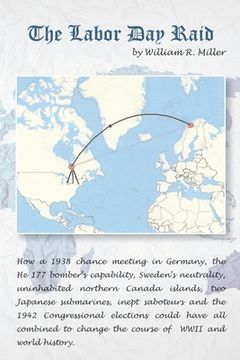Compartir
The Labor Day Raid: How a 1938 meeting in Germany, Neutral Sweden, A Canadian Island, Japanese Submarines, Nazi Saboteurs and the 1942 US
William R. Miller
(Autor)
·
Independently Published
· Tapa Blanda
The Labor Day Raid: How a 1938 meeting in Germany, Neutral Sweden, A Canadian Island, Japanese Submarines, Nazi Saboteurs and the 1942 US - Miller, William R.
Sin Stock
Te enviaremos un correo cuando el libro vuelva a estar disponible
Reseña del libro "The Labor Day Raid: How a 1938 meeting in Germany, Neutral Sweden, A Canadian Island, Japanese Submarines, Nazi Saboteurs and the 1942 US"
Background WWI to 1938Like many books about WWII, the story really begins with the Treaty of Versailles that ended WWI. President Wilson's isolationist Congress refused to ratify the Treaty version he had brought back and also refused to have the United States join the newly formed League of Nations. Without the moderating influence of Wilson, Lloyd George of England and Clemenceau of France redrew the maps of Europe and the Middle East (the former Ottoman Empire) to suit the strategic interests of England and France. The Allies also imposed such crushing reparations on Germany and Austria that the subsequent runaway inflation and depression destroyed the their muddle class.When the 1930's rolled around, it turned out to be the beginning of a remarkable period for Germany to get away with reversing many of the provisions and limitations of the Treaty of Versailles; This was, to a great degree, because the world in general and the League of Nations in particular were distracted by a whole series of major invasions and civil wars all over the world.The decade kicked off with Japan invading Manchuria. The League objected but took no substantive action. The United States, who perceived that Japan with its major army and navy (and associated air corps) represented a threat to America's position in the Pacific, began to impose increasing sanctions and embargos to try to force the Japanese to back off. The Japanese kept rolling south through China through the 30's, ignoring the League and resenting American interference. Next, in 1935, Mussolini invaded Ethiopia to expand Italy's colonies in western Africa. The League of Nations protested, with Britain taking the lead backed up by sanctions and diplomacy. France however, under Laval, seemed to provide only lukewarm support to the effort to restrain Mussolini. The other League member nations and the US did not strongly support the Ethiopian cause with money or armaments. In one of those "world turned upside down" moments, it was the Germans who ultimately supplied the modern arms the Ethiopians needed. While the war in Ethiopia dragged on, civil war broke out in Spain in 1936. The attention of the world and the League of Nations now shifted to that conflict with Germany and Italy supporting the Fascist/Royalist rebels and the Soviet Union supporting the Loyalists.Under cover of all these distractions, Germany was able to get away with rearming and also with a series of "land grabs" without provoking any reaction by the League or the US.1938 onThis book picks up the narrative in 1938. It postulates an entirely different historical scenario from 1942 onward, triggered initially by the consequences of a chance encounter at a glider meet in Germany in 1938. The Labor Day Raid four years later, which is the subject of this book, was the final outcome of that meeting. That raid (had it actually occurred) could have become the centerpiece of a series of other events that did occur in 1942 that together would have tended to increase the (already strong) isolationist sentiment in the United States at the time. This could in turn have affected the results of the 1942 election in the US sufficiently so that WWII and its aftermath were radically altered.In order to preserve the "flow" of the story as it unravels, I have placed background information in Appendices, which the reader can refer to if seeking further detail. The material in the Appendices is all factual to the best of my knowledge. The fictional body of the book is woven around these and other factual information and events.

